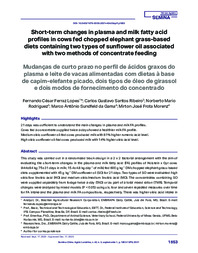Short-term changes in plasma and milk fatty acid profiles in cows fed chopped elephant grass-based diets containing two types of sunflower oil associated with two methods of concentrate feeding.
Short-term changes in plasma and milk fatty acid profiles in cows fed chopped elephant grass-based diets containing two types of sunflower oil associated with two methods of concentrate feeding.
Author(s): LOPES, F. C. F.; RIBEIRO, C. G. S.; RODRIGUEZ, N. M.; GAMA, M. A. S. da; MORENZ, M. J. F.
Summary: This study was carried out in a randomized block design in a 2 x 2 factorial arrangement with the aim of evaluating the short-term changes in the plasma and milk fatty acid (FA) profiles of Holstein x Gyr cows (444±84 kg; 75±31 days in milk; 15.4±4.8 kg day-1 of milk) fed 600 g kg-1 DM chopped elephant grass-based diets supplemented with 45 g kg-1 DM sunflower oil (SO) for 21 days. Two types of SO were evaluated: high oleic/low linoleic acid (HO) and medium oleic/medium linoleic acid (MO). The concentrates containing SO were supplied separately from forage twice a day (TAD) or as part of a total mixed ration (TMR). Temporal changes were analyzed by mixed models (P < 0.05) using six, four and seven repeated measures over time for FA intake and the plasma and milk FA compositions, respectively. There was higher oleic acid intake in HO SO-fed cows, while higher linoleic and α-linolenic acid intake were observed in MO SO-fed cows. TAD-fed cows had a higher plasma vaccenic acid content than TMR-fed cows, while MO SO-fed cows had higher plasma vaccenic and rumenic acid contents than HO SO-fed cows. As a function of day, there were linear increases in oleic and linoleic acid intake; plasma contents of oleic, vaccenic and linoleic acids; and the milk fat content of linoleic acid, while quadratic effects were adjusted for the milk fat contents of palmitic, oleic, vaccenic and rumenic acids. In comparison with TMR-fed cows, the milk fat of TAD-fed cows produced between days 13 and 17 showed an FA profile that was more nutritionally desirable for human health, with lower contents of hypercholesterolemic FAs and higher contents of oleic, rumenic and vaccenic acids. Between days 15 and 16, the vaccenic and rumenic acid contents in the milk fat of MO SO-fed cows were 81% higher than those obtained from HO SO-fed cows, which on the 14th day had a 14% higher oleic acid content in milk fat. Lower milk fat levels of hypercholesterolemic FAs were produced between days 13 and 14 by cows fed both types of SO.
Publication year: 2021
Types of publication: Journal article
Unit: Embrapa Dairy Cattle
Observation
Some of Embrapa's publications are published as ePub files. To read them, use or download one of the following free software options to your computer or mobile device. Android: Google Play Books; IOS: iBooks; Windows and Linux: Calibre.
Access other publications
Access the Agricultural Research Database (BDPA) to consult Embrapa's full library collection and records.
Visit Embrapa Bookstore to purchase books and other publications sold by Embrapa.

